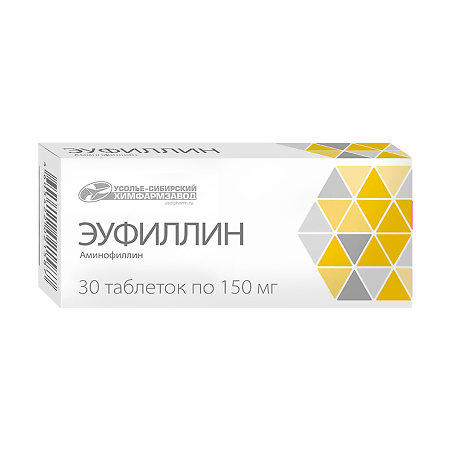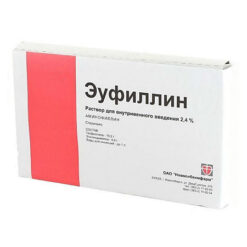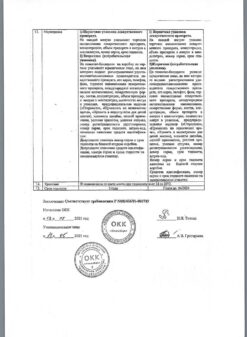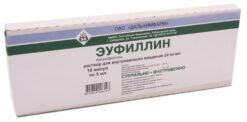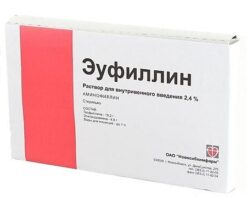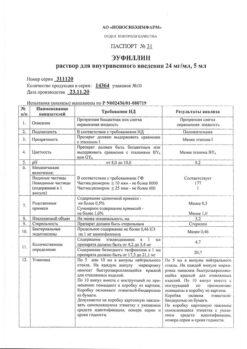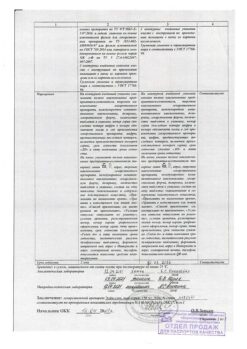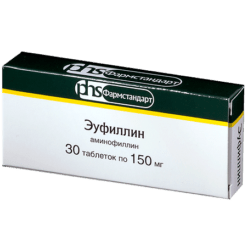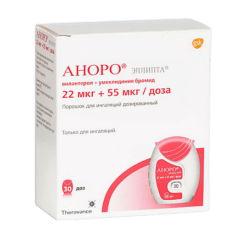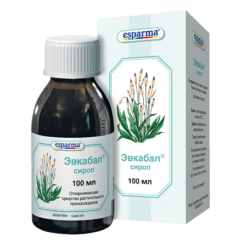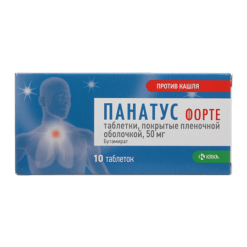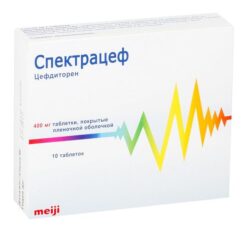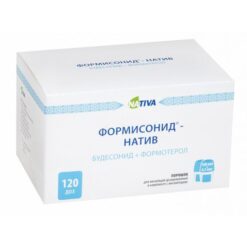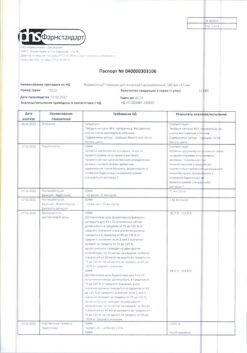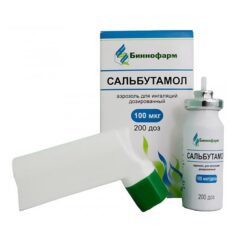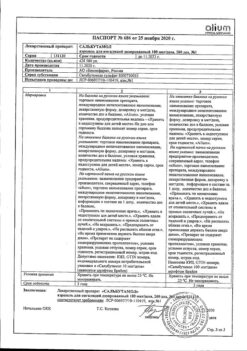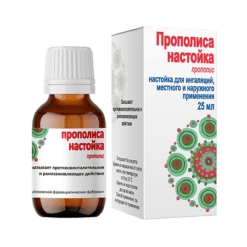No products in the cart.
Eufylline, tablets 150 mg 30 pcs
€1.00
Description
Pharmacotherapeutic group: Bronchodilator – phosphodiesterase inhibitor.
ATX code: R03DA05
Pharmacological action
Eufylline is a bronchodilator, a xanthine derivative; It inhibits phosphodiesterase, increases the accumulation of cyclic adenosine monophosphate in tissues, blocks adenosine (purine) receptors; reduces the flow of calcium ions through cell membrane channels, reduces the contractile activity of smooth muscles.
Relaxes bronchial muscles, increases mucociliary clearance, stimulates diaphragm contraction, improves respiratory and intercostal muscles function, stimulates respiratory center, increases its sensitivity to carbon dioxide and improves alveolar ventilation, which finally leads to decrease of severity and frequency of apnea episodes. By normalizing respiratory function, it helps to saturate the blood with oxygen and reduce the concentration of carbon dioxide. It has a stimulating effect on heart activity, increases the force and number of heart contractions, increases coronary blood flow and myocardial oxygen demand. It reduces the tone of blood vessels (mainly blood vessels of the brain, skin and kidneys).
It has a peripheral venodilator effect, reduces pulmonary vascular resistance, reduces the pressure in the “small” circle of the circulation. Increases renal blood flow, has a moderate diuretic effect. Dilates extrahepatic biliary tracts. Inhibits platelet aggregation (inhibits platelet activation factor and PgE2 alpha), increases resistance of erythrocytes to deformation (improves rheological properties of blood), reduces thrombosis and normalizes microcirculation. It has a tocolytic effect, increases the acidity of gastric juice.
When used in high doses it has enileptogenic effect.
Pharmacokinetics
After oral administration is quickly and completely absorbed, bioavailability – 90 – 100%. Food reduces the absorption rate without affecting its magnitude (large amounts of liquid and proteins accelerate the process). The higher the dose taken, the lower the absorption rate. Time to reach Cmax is 1-2 hours. Distribution volume is in the range of 0.3-0.7 l/kg (30-70% of the “ideal” body weight), on average 0.45 l/kg. Binding to plasma proteins in adults is 60%, in patients with liver cirrhosis – 36%. It penetrates into breast milk (10% of the dose taken), through the placental barrier (concentration in fetal serum is slightly higher than in the serum of the mother).
The bronchodilator properties of aminophylline occur at concentrations of 10- 20 µg/ml. Concentrations above 20 mg/ml are toxic.
The excitatory effect on the respiratory center is realized at lower blood concentrations of 5-10 µg/ml. It is metabolized at physiological pH values with release of free theophylline, which is further metabolized in the liver with the participation of several cytochrome P450 isoenzymes. As a result, 1,3-Dimethylureic acid (45-55%) is formed, which has pharmacological activity, but is 1-5 times inferior to theophylline.
Caffeine is an active metabolite and is formed in small amounts. There is no caffeine cumulation phenomenon in children over 3 years of age and in adults (unlike in younger children). Half-life in children over 6 months – 3.7 hours; in adults – 8.7 hours; in “smokers” (20-40 cigarettes per day) – 4-5 hours (after quitting smoking normalization of pharmacokinetics in 3-4 months); in adults with chronic obstructive pulmonary disease, “pulmonary” heart and pulmonary-heart failure – over 24 hours. It is excreted by the kidneys.
Indications
Indications
Broncho-obstructive syndrome of any origin: bronchial asthma (drug of choice in patients with exercise-induced asthma and as an additional remedy for other forms), chronic obstructive pulmonary disease, pulmonary emphysema, chronic obstructive bronchitis, pulmonary hypertension, cor pulmonale, sleep apnea.
Pharmacological effect
Pharmacological effect
Pharmacotherapeutic group: Bronchodilator – phosphodiesterase inhibitor.
ATX code: R03DA05
Pharmacological action
Eufillin is a bronchodilator, a xanthine derivative; inhibits phosphodiesterase, increases the accumulation of cyclic adenosine monophosphate in tissues, blocks adenosine (purine) receptors; reduces the flow of calcium ions through the channels of cell membranes, reduces the contractile activity of smooth muscles.
Relaxes the bronchial muscles, increases mucociliary clearance, stimulates contraction of the diaphragm, improves the function of the respiratory and intercostal muscles, stimulates the respiratory center, increases its sensitivity to carbon dioxide and improves alveolar ventilation, which ultimately leads to a decrease in the severity and frequency of apnea episodes. By normalizing respiratory function, it helps saturate the blood with oxygen and reduce the concentration of carbon dioxide. It has a stimulating effect on the activity of the heart, increases the strength and number of heart contractions, increases coronary blood flow and myocardial oxygen demand. Reduces the tone of blood vessels (mainly those of the brain, skin and kidneys).
It has a peripheral venodilating effect, reduces pulmonary vascular resistance, and reduces pressure in the “lesser” circulation. Increases renal blood flow and has a moderate diuretic effect. Expands extrahepatic bile ducts. Inhibits platelet aggregation (suppresses platelet activating factor and PgE2 alpha), increases the resistance of red blood cells to deformation (improves the rheological properties of blood), reduces thrombus formation and normalizes microcirculation. It has a tocolytic effect, increases the acidity of gastric juice.
When used in large doses, it has an enileptogenic effect.
Pharmacokinetics
After oral administration, it is quickly and completely absorbed, bioavailability is 90 – 100%. Food reduces the rate of absorption without affecting its magnitude (large volumes of liquid and proteins speed up the process). The higher the dose taken, the lower the absorption rate. The time to reach Cmax is 1-2 hours. The volume of distribution is in the range of 0.3-0.7 l/kg (30-70% of the “ideal” body weight), on average 0.45 l/kg. The connection with plasma proteins in adults is 60%, in patients with liver cirrhosis – 36%. Penetrates into breast milk (10% of the dose taken), through the placental barrier (the concentration in the fetal blood serum is slightly higher than in the maternal serum).
Aminophylline exhibits bronchodilating properties in concentrations of 10-20 mcg/ml. Concentrations above 20 mg/ml are toxic.
The stimulating effect on the respiratory center is realized at a lower content of the drug in the blood of 5-10 mcg/ml. Metabolized at physiological pH values with the release of free theophylline, which is further metabolized in the liver with the participation of several cytochrome P450 isoenzymes. As a result, 1,3-Dimethyluric acid (45-55%) is formed, which has pharmacological activity, but is 1-5 times inferior to theophylline.
Caffeine is an active metabolite and is formed in small quantities. In children over 3 years of age and in adults (unlike younger children), the phenomenon of caffeine accumulation is absent. The half-life in children over 6 months is 3.7 hours; in adults – 8.7 hours; for “smokers” (20-40 cigarettes per day) – 4-5 hours (after quitting smoking, pharmacokinetics normalize after 3-4 months); in adults with chronic obstructive pulmonary disease, pulmonary heart disease and pulmonary heart failure – over 24 hours. Excreted by the kidneys.
Special instructions
Special instructions
Use caution when consuming large quantities of caffeine-containing foods or drinks.
The effect of the drug on the ability to drive vehicles and machinery
During the treatment period, it is necessary to refrain from driving vehicles and engaging in other potentially hazardous activities that require increased concentration and speed of psychomotor reactions.
Active ingredient
Active ingredient
Aminophylline
Composition
Composition
Composition per 1 tablet:
Active ingredients: aminophylline 150 mg.
Excipients: potato starch – 48.0 mg, calcium
stearate – 2.0 mg.
Pregnancy
Pregnancy
Be careful during pregnancy and lactation.
Contraindications
Contraindications
Hypersensitivity (including to other xanthine derivatives: caffeine, pentoxifylline, theobromine), epilepsy, peptic ulcer of the stomach and duodenum (in the acute stage), gastritis with high acidity, severe arterial hyper- or hypotension, tachyarrhythmias, hemorrhagic stroke, retinal hemorrhage, children’s age (up to 3 years).
With caution.
Severe coronary insufficiency (acute phase of myocardial infarction, angina pectoris), widespread vascular atherosclerosis, hypertrophic obstructive cardiomyopathy, frequent ventricular extrasystole, increased convulsive readiness, liver and/or renal failure, peptic ulcer of the stomach and duodenum (history), recent bleeding from the gastrointestinal tract history, uncontrolled hypothyroidism (possibility of cumulation) or thyrotoxicosis, prolonged hyperthermia, gastroesophageal reflux, prostatic hyperplasia, pregnancy, lactation, old age, childhood. Prescribed simultaneously with anticoagulants.
Side Effects
Side Effects
From the nervous system: dizziness, headache, insomnia, agitation, anxiety, irritability, tremor.
From the cardiovascular system: palpitations, tachycardia (including in the fetus when taken by a pregnant woman in the third trimester), arrhythmias, cardialgia, decreased blood pressure, increased frequency of angina attacks.
From the digestive system: gastralgia, nausea, vomiting, gastroesophageal reflux, heartburn, exacerbation of peptic ulcer, diarrhea, with long-term use – loss of appetite.
Allergic reactions: skin rash, itching, fever.
Other: chest pain, tachypnea, flushing, albuminuria, hematuria, hypoglycemia, increased diuresis, increased sweating.
Interaction
Interaction
Increases the likelihood of developing side effects of glucocorticosteroids, mineralocorticosteroids (hypernatremia), general anesthesia (increases the risk of ventricular arrhythmias), xanthines and drugs that excite the central nervous system (increases neurotoxicity), beta-agonists. Antidiarrheal drugs and enterosorbents reduce the absorption of aminophylline. Rifampicin, phenobarbital, phenytoin, isoniazid, carbamazepine, sulfinpyrazone, aminoglutethimide, oral estrogen-containing contraceptives and moracizine, being inducers of microsomal liver enzymes, increase the clearance of aminophylline, which may require an increase in its dose.
When used simultaneously with macrolide antibiotics, lincomycin, allopurinol, cimetidine, isoprenaline, enoxacin, small doses of ethanol, disulfiram, fluoroquinolones, recombinant interferon-alpha, methotrexate, mexiletine, propafenone, thiabendazole, ticlopidine, verapamil and when vaccinated against influenza, the intensity of action of aminophylline may increase, which may require a reduction in its dose. Enhances the effect of beta-adrenergic stimulants and diuretics (including by increasing glomerular filtration), reduces the effectiveness of lithium preparations and beta-blockers. Compatible with antispasmodics, do not use in combination with other xanthine derivatives.
Overdose
Overdose
Symptoms: loss of appetite, gastralgia, diarrhea, nausea, vomiting (including blood), gastrointestinal bleeding, tachypnea, flushing of the facial skin, tachycardia, ventricular arrhythmias, insomnia, motor agitation, anxiety, photophobia, tremor, convulsions. In severe poisoning, epileptoid seizures may develop (especially in children without any warning signs), hypoxia, metabolic acidosis, hyperglycemia, hypokalemia, decreased blood pressure, skeletal muscle necrosis, confusion, renal failure with myoglobinuria.
Treatment: drug withdrawal, gastric lavage, use of activated charcoal, laxatives, intestinal lavage with a combination of polyethylene glycol and electrolytes, forced diuresis, hemosorption, plasma sorption, hemodialysis (effectiveness is not high, peritoneal dialysis is not effective), symptomatic therapy (including metoclopramide and ondansetron – for vomiting). If convulsions occur, maintain airway patency and administer oxygen therapy. To stop a seizure, use intravenous diazepam 0.1-0.3 mg/kg (but not more than 10 mg). For severe nausea and vomiting, use metoclopramide or ondansetron (iv).
Storage conditions
Storage conditions
In a place protected from light, at a temperature not exceeding 25°C. Keep out of the reach of children.
Shelf life
Shelf life
5 years. Do not use after expiration date.
Manufacturer
Manufacturer
Usolye SHFZ, Russia
Additional information
| Shelf life | 5 years. Do not use after the expiration date. |
|---|---|
| Conditions of storage | Store in a dark place at a temperature not exceeding 25°C. Keep out of reach of children. |
| Manufacturer | Usolye SCFZ, Russia |
| Medication form | pills |
| Brand | Usolye SCFZ |
Other forms…
Related products
Buy Eufylline, tablets 150 mg 30 pcs with delivery to USA, UK, Europe and over 120 other countries.

